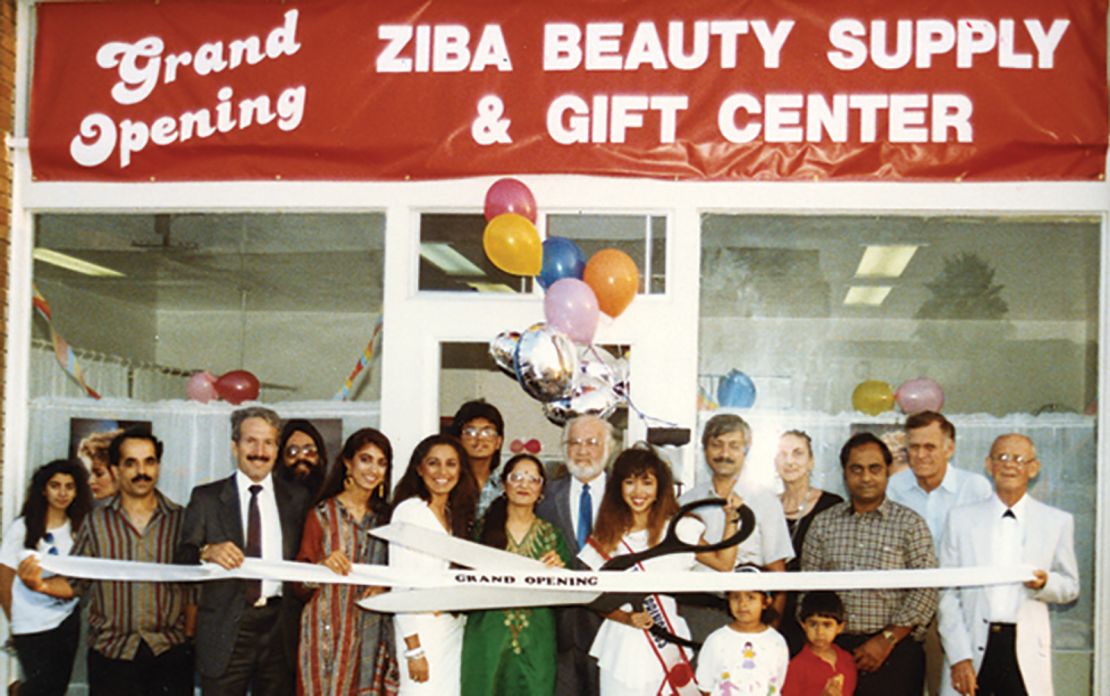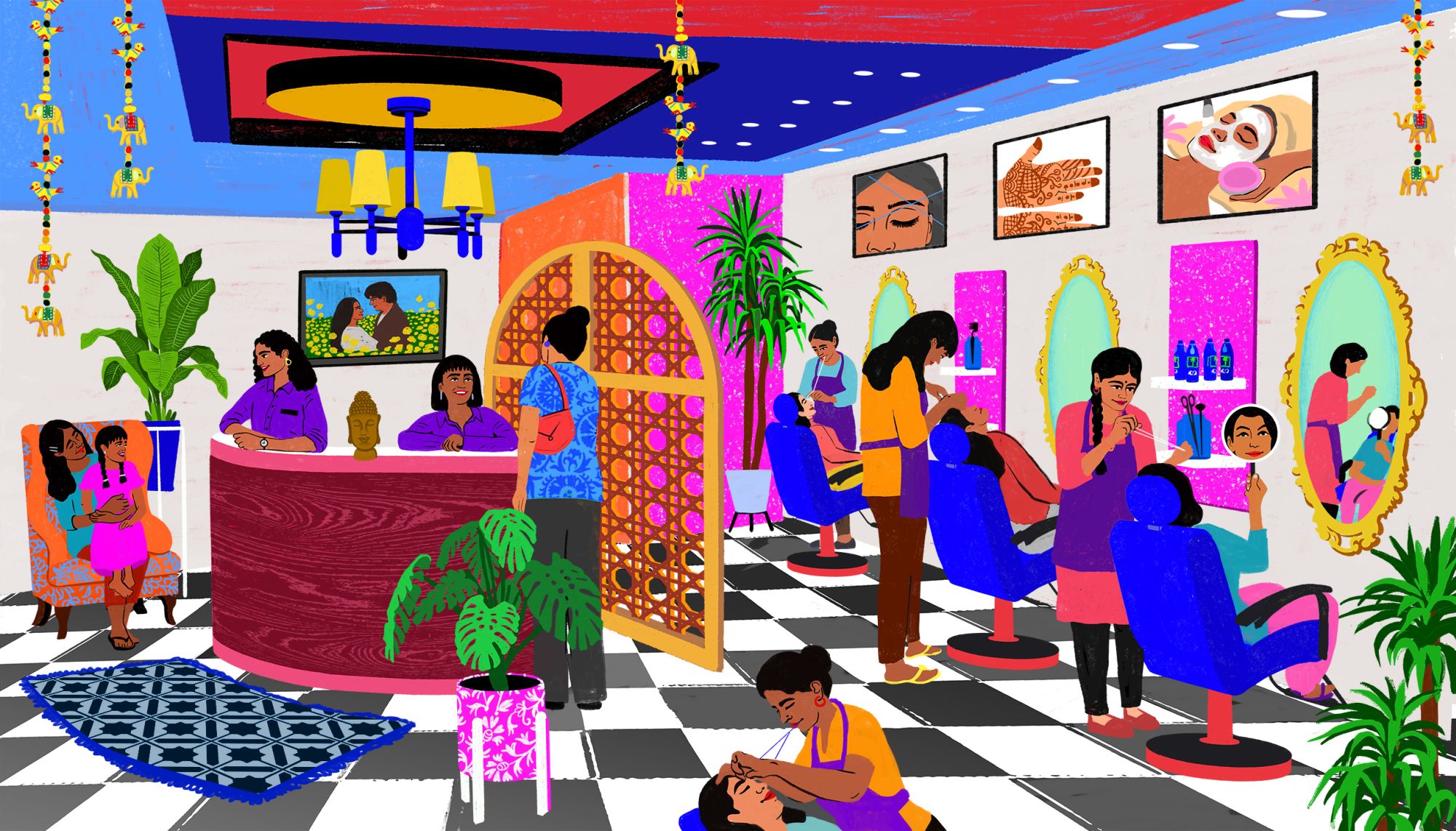Editor’s Note: This feature is part of CNN Style’s new series Hyphenated, which explores the complex issue of identity among minorities in the United States.
It’s been a year since Misbah Etman, a real estate agent in Los Angeles, stepped foot in a salon for any kind of beauty treatment, but threading is the one she has missed the most.
Before the pandemic, Etman frequented her go-to salon every few weeks for brow-shaping appointments. Like many South Asian American women, she found that the routine did as much for her mindset as it did her appearance.
“(I miss) that clean feeling that makes me think I can handle the world,” said Etman. “If my eyebrows are unruly, the rest of my life is too.”
South Asian-owned beauty parlors like Etman’s LA favorite, can be found across America. In some, Bollywood music videos will play on a television in the background. In others, a religious symbol near the cash register might hint at the owner’s beliefs: a small Hindu altar, a Buddha miniature or a plaque with Islamic calligraphy. Stations will often be abuzz with soft chatter punctuated by loud goodbyes from customers waving at the door. The bustle of comings and goings is usually constant.
In front of vanity mirrors, threading artists clad in kurti tops or salon aprons may be seen standing over reclining clients, who stretch the skin taut themselves. Cotton thread looped around their fingers, the practitioners move deftly to pluck delicate facial hairs. The service is typically over in a matter of minutes.
This vision of an archetypical salon may not be familiar to everyone in America who has undergone threading, which in recent decades, has become a popular way for people of all backgrounds to shape their brows and remove facial hair. But for women in the South Asian American diaspora, these kinds of spaces have become especially important sources of connection, familiarity and a complicated sense of belonging.
“(A salon is) a space … where South Asians see themselves in their fullness,” said Hareem Khan, an assistant professor of anthropology and ethnic studies at California State University, San Bernardino.
Culture and kinship
Within the South Asian community, threading falls somewhere between a universal cultural practice and a non-negotiable act of maintenance.
In previous generations, South Asian women would first get threaded in preparation for their wedding day. But today, girls typically start threading around the time they hit puberty, beginning what is often a lifelong commitment.
Many South Asians have body and facial hair that is naturally thick and dark, while beauty norms cast its removal as a marker of femininity and hygiene (a view that is, increasingly, being called into question). Threading is a quick and cost-effective way to remove unwanted hair from the upper lip, chin, forehead and cheeks, or to shape existing brow hair to accentuate the eyes and open up the face.
“(South Asian women) will give up their Starbucks but not their eyebrows,” said Sumita Batra, CEO of Ziba Beauty, a chain of family-run threading salons in California. “It’s really self-enhancement … It’s self-love.”

While the historic origins of threading are disputed (various sources have claimed the practice originated in Middle East, China and India) many American threading salons are South Asian-owned and -operated.
In large American cities like Los Angeles and Chicago, burgeoning South Asian American enclaves began taking shape in the late 1980s. Immigrant women started offering threading services out of their living rooms and garages, advertising through word-of-mouth. Others started modest salons in the back rooms of sari shops, or strip malls near South Asian grocery stores.
When Batra’s mother, Kundan Sabarwal, opened the first branch of Ziba Beauty in Artesia, California, in 1988, it was a predominantly women-only space that catered to an exclusively South Asian clientele. Threading’s relative affordability (Ziba Beauty charged just $5 for brows when it first opened) made it a singular self-care ritual accessible across class lines.
The salons were one of the few places where South Asian immigrant women could socialize with one another, both as patrons and employees. People often relied on them to provide traditional beauty services they couldn’t find elsewhere, like threading and henna application, as well as certain waxing and facial techniques.
Then, like now, immigrants and working-class women gravitated toward the salons for employment. Despite the prospect of long hours and low wages, many artists prefer threading over other service jobs because of the sense of community it offers, according to Preeti Sharma, an assistant professor of American studies at California State University, Long Beach, who has written a dissertation on the subject. “There is something about folks wanting to work with others in their community, and a kind of comfort,” Sharma said in a phone interview.
In smaller salons, she added, women will help each other with transportation and childcare, share food and speak a common language.
This sense of kinship also exists between threading artists and their clients, according to Sridevi Kalvacherla, an Indian immigrant and independent threading artist in Tempe, Arizona. Kalvacherla started seeing customers in her home when the pandemic forced the salon she works at to close. “(They’re) not even like clients now. It’s like a family,” she said, recalling conversations about recipes, festivals, jewelry and saris. Kalvacherla especially loves cooking Indian dishes and serving them to her clients. “They get that homey feeling (from me),” she added.
Pre-pandemic, Aruna Cadambi, a corporate responsibility manager in New York City, saw her threading artist every two to three weeks. They started off discussing things like Cadambi’s wedding plans but gradually delved deeper into body image issues and talking about quarrels with family and friends. “We built a relationship of trust naturally over time,” she said.
Their working relationship provided a degree of anonymity, making Cadambi feel like she could confide in her beauty technician more readily than she could some friends. Eventually, they became so close that in 2018, when logistical issues prevented Cadambi’s mother, aunt and cousins from performing her “haldi-besan,” a private pre-wedding ritual where close female relatives apply turmeric paste to the bride’s skin, she entrusted her threading artist with the duty. She extended the offer not only due to the pair’s special bond, but because the threader came from a similar cultural background and understood the custom.
The intimacy and trust required for threading (which “can have disastrous results if it’s not done properly,” said Khan) may also partly explain the close rapport that can develop between artists and their customers. If practitioners change jobs, it is not unusual for clients to follow them to their new salon, even if it is less convenient to travel to.
The flaws in familiarity
For many women in the South Asian diaspora, threading is also a survival tactic. Being teased at a young age, often by male peers, for having a mustache or “unibrow,” or being called dirty and hairy, is a near-universal experience. As adults, moving in spaces where having “foreign” features can attract further discrimination, threading dark facial hair away offers one way to stand out less.
Navigating the politics around race, beauty and assimilation, it’s not surprising that South Asian clients often seek a threader who is also of South Asian descent. “This person, without me even needing to fully communicate myself, knows how to handle my concerns,” Khan said.
But this familiarity can have its downsides. It’s common to walk into a salon for one service, only to be met with unwelcome suggestions for others: fix hairy arms with waxing, eradicate acne with a facial, dye unsightly gray hair. “You feel a little on edge because you know you’re going to be called out,” Khan said.
Critical comments are perhaps to be expected from businesses that rely on customers’ aesthetic aspirations. But they may also illustrate generational and cultural disconnects between threaders and their clients.
At a young age, Khan said she was advised to thread her whole face in an effort to make her brown skin look lighter – a comment in keeping with widespread colorist attitudes within the South Asian community. These comments troubled her, but over time she understood it as a way in which care was communicated, however misguided. “I don’t see it as necessarily malicious,” she said. “It’s enacting through this lens of familiarity – and all the good and bad that comes with it.”
As both a social space to connect with culture and community, and one that reinforces (in some cases outdated) beauty ideals, the role of threading salons continues to evolve among South Asian Americans.
“The way we feel in a diasporic space is always going to be a complicated feeling … The salon is a microcosm of that tension,” Khan said.
Illustrations by artist Neethi (IG: @kneethee)
